#angular philippines
Explore tagged Tumblr posts
Text
A practical guide to selecting your web frontend framework
When starting a new web application project, choosing the preferred web frontend framework can often be a long and serious point of discussion. In this article, we hope to provide developers with a guide to selecting a suitable web frontend framework for different types of projects. JavaScript or TypeScript When we talk about frontend web development in the year 2023 and for probably the next…

View On WordPress
#angular developer philippines#angular philippines#angularjs#frontend developer philippines#react philippines#react vs vue vs angular#reactjs#reactjs developer philippines#vue philippines#vuejs developer philippines#web design#web development#web programming
0 notes
Text
Some General Marauders Era Headcanons
NOT canon compliant (I don’t care about jk shitface’s canon lol)
Regulus Black (the main character as far as I’m concerned)
~ French, I mean cmon the Black family motto is toujours pur for gods sake. He absolutely speaks French. Other than that, they can be traced to German (Walburga’s side) and English heritage.
~cis bi boy (sapiosexual?)
~ c-ptsd, depression
~ messy curly medium-length hair, long nimble fingers, one of those people with a few lovely moles in choice locations, slutty waist, angular jaw, kind of set in eyes, not tall but a bit taller than Sirius
~ most dogs freak him out (lol oof)
Sirius Black
~ french (& English, German) ofc.
~ amab queer, omnisexual mlm
~c-ptsd, adhd
~ wavy long black hair, also a slutty waist, not very tall, squinty eyes, latently a little muscular
~ big believer in a leather jacket
James Potter
~ I stan desi Potter. But also love the idea of Euphemia being Greek per her name so Jamie boy is part Greek and part Pakistani on Fleamont’s side. He only speaks English but has some terms and things from both Greek and Hindi.
~ cis bi guy
~adhd
~ needs glasses ofc, I imagine he’s super nearsighted.
~ super messy hair, lean and muscular, medium tall
~ red converse wearer
Remus Lupin
~ Welsh, English, and Portuguese. He speaks only English.
~ amab, queer, demisexual?
~ anxiety
~ chronic pain from wolf injuries
~ scarred all over, light brown hair, tan, he’s the tallest, skinny but not lacking muscle, limps sometimes and often needs to stretch his sore muscles, hairy!!
~ always wearing a sweater
Peter Pettigrew
~ English & German. Speaks English.
~ cis, bi
~ anxiety, definitely does self-soothing movements
~ fat !! no skinny wormtail in this house, wavy blonde hair, the cutest cheeks known to man, callouses on his hands and no one can figure out why
~ asthma
~ loves naps
Pandora Rosier
~ Another family who absolutely must be fluent French speakers. So I think they have some Afro-Caribbean on one side and the other is very much originally French. Speaks English and French.
~ cis fem, pansexual, demiromantic
~ autistic
~ hair is super light blonde and looooong in dreads, light blue eyes, brown skin, quite tall and thin, all her features are super delicate and lithe, she’s kind of otherworldly tbh but she certainly doesn’t act so she’s got quite the mad scientist competitive streak
~ amazing at charms
Evan Rosier
~ Afro-Caribbean, French, English. Speaks English and French.
~ he/they, omnisexual (and by that I mean he fucks everyone ha-hey)
~ super light blonde hair either cropped or in a protective style, brown skin, light brown eyes, braces, dead average build, but still suave af don’t be mistaken everyone wants this kid, not hairy
Lily Evans
~ English and Scottish, speaks English.
~ cis gal, questioning but likely demisexual
~ fat!!, straight-ish red hair ofc, freckles, green eyes, cute small chubby hands, radiant smile
Barty Crouch Jr.
~ English, speaks English and all curse words in every language he could get people to teach them in.
~ queer amab bisexual
~ I won’t begin to try to dissect the workings of Barry’s brain but depression could be a start
~ eidetic memory
~ needs reading glasses? but like most of the time they’re not on him or they’re broken. so he just like uses his crazy big brain to just remember stuff or else he mostly never reads outside of studying times
~ brown hair but whenever he gets the chance he buzzes or dyes it green for fun, stick and pokes and self done piercings, tall but not Remus tall, lean muscular, hairy ass legs
Dorcas Meadowes
~ Ethiopian and English. Speaks English.
~ cis girl, sapphic
~ dark skin, black hair often in long braids, dark eyes, athletic curvy build, long fingers
~ literally prodigy herbologist, also amazing at potions and divination
Marlene McKinnon
~ Filipino!!!!!!!!!!!! speaks English and Filipino (maybe some of another regional language of the Philippines).
~ cis girl, sapphic
~ adhd, depression
~ lactose intolerant
~ short queen, freckles, dyed blonde but def experiments with color and cut, usually straight or a little wavy, muscular but it doesn’t really show she just seems kinda thin, some stick and pokes, several ear piercings
~ wears red cowboy boots, studded belts, low rise, cut up t shirts, hats
Mary Macdonald
~ Brazilian on one side and South African & English on the other. Speaks English and Portuguese.
~ cis girl, bisexual
~ ehler’s danlos syndrome
~ wears her dark hair natural curly, curvy, average height, belly button pierced, huge gorgeous smile, adorable button nose
lol
Severus Snape
~English and Polish. Speaks English.
~ cis, hetero
~ depression, anxiety
~ straight long black hair, pale, Remus tall, fairly average weight, dark eyes, strong nose
~wears mostly black
~ amazing at potions
#marauders#regulus black#sirius black#remus lupin#james potter#lily evans#peter pettigrew#marlene mckinnon#mary macdonald#barty crouch jr#evan rosier#pandora rosier#severus snape#dorcas meadowes#myreggie
37 notes
·
View notes
Text
yeah i doubt it
11:07 p.m. on my table still but in a happier state than before
I came on here because I just redownloaded all of my socials after deleting the apps to focus on work and real life situations (which always get a little hectic around the holidays), so I only just now saw Franco Colapinto's video where he states that he is a Sagittarius rising, and in the same breath says he is a Pisces descendant.
Which is, you know. Wrong. Pisces is the IC, Gemini is the DSC point if you have a Sagittarius ASC no matter what house system you use because the angles are angled in such a way that they are roughly around 90-180 deg away from each other.
Buuuut Astrotheme, one of my beloved astrology sites, has recently update 43's chart rating as A, as collected by Sy Scholfield. He is listed as Sagittarius rising through memory- which I'm assuming is also based on that video where he says it to a fan, as it was calculated in the second decan of Sagittarius at 16 degrees- the literal middle of the whole 30 degrees of the sign.
As much as I love Astrotheme (it's got a good database despite being free software, much like astro-seek and astro.com), I don't think it should be rated A even if it did come straight from the horse's mouth. It is completely plausible that he- by virtue of being early 2000s Gen Z as well as being a native Spanish speaker*- would remember his Rising sign better than his Descendant sign (which is generally only calculated or mentioned, really, when in terms of partners/girlfriends/boyfriends of relationship astrology, because usually guys his age mostly know about astrology because of girls his age), but he could have had someone really give him a reading and detailing his chart, and him being confused in the moment about which term was used in which.
In whichever case, according to Franco himself, he would still be a mutable Ascendant point, either a Virgo or Sagittarius rising, and his Gemini Sun would be angular, either in 7H of partners/contracts or 10H of career/public image.
While I think there is still every chance that he has Virgo rising- he doesn't look like it. He is too chill to be one- as Virgo is ruled by Mercury (the mind), and they are flighty and nervous and tend to have obsessive worries and whatnot. He just looks like a chill guy.

To be fair, he doesn't look much like a Sagittarius rising either. His Taurus placements shine through so much (6H in Sagittarius, 9H in Virgo) with those sleepy eyes, more prominent neck when compared to other racers, and a softness to his face that is usually not present when someone has Pluto in Sagittarius on the 1H of the self.
He is also young. He has yet to grow into his face. It will change, the same way that Charles Leclerc's [Libra Sun-Scorpio ASC] face went from baby Harry Potter to Monegasque fanon Tony Stark after puberty, or Max Verstappen's [Sagittarius Rising-with Mars in 1H] face looking less swollen, red-faced and puffy as he grows older**, or Esteban Ocon [night chart, Leo rising with Mars and Venus in 1H] and Lewis Hamilton [possible day chart, possible Pisces rising with Venus and Mars in 1H] having the sharpness (Mars) of their faces be smoothed out with fat (Venus, to a lesser degree than Jupiter) as Venus matures after 25 years of age so they look more oval than arrow-like.
It doesn't matter though- as long as he's not on the grid for the 2025 season, there wouldn't be a need to read the astroweather for him, as I don't watch F2.
(30) 11:50 p.m.
*I will always assume that any native Spanish speaker outside of the Philippines and Spain casually knows at least their Sun, Moon, and Rising because of famous Puerto Rican astrologer Walter Mercado and the popularity of his readings. The Philippines, while superstitious, generally practice a lot more folk Catholicism, Chinese astrology, and Feng Shui owing to their neighbors, and I don't know much about Spain's occult situation.
**Mars in a person's chart matures after 28 years. Since it is a racing planet, expect for him to face some challenges next year, since he is a day chart and Mars is the malefic out-of-sect. Ocon's night chart (but sad Solarian placement) would be good to compare with his as he is also a fellow 1H Mars who has already turned 28 in 2024.
3 notes
·
View notes
Text
I started playing D&D with a friend a little over a year ago, and one of the things that we wanted to do with the campaign was to be able to see both our cultures and other cultures represented in the fantasy world that we would be playing in, because, frankly, a lot of the fantasy media we grew up with was pretty dang white. I’ve ended up pulling parts of Vietnamese culture, because I’m Vietnamese, he’s pulled from his culture, and that’s been really fun to see.
Anyway, my character, Keri, is a dwarf, and is a character I had previously played in a campaign with mostly white friends, where we weren’t thinking about including our cultures in this way. And as I was doing some prep and thinking about aspects of dwarven culture for this current campaign, I decided that instead of basing the dwarven writing system on runes, which is what Tolkien's and D&D's dwarven writing system is based on, dwarves in this setting would have a writing system inspired by cuneiform, which is a writing system from ancient Mesopotamia.
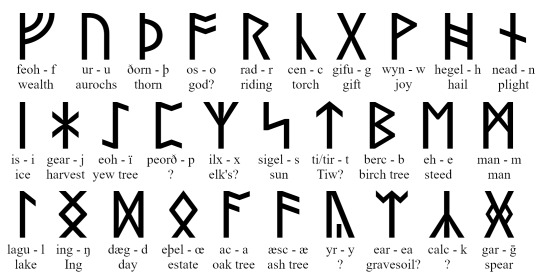
[image description: A chart which shows 30 Anglo-Saxon "futhorc" runes. It shows their names, transliteration characters, and the meanings of their names.]
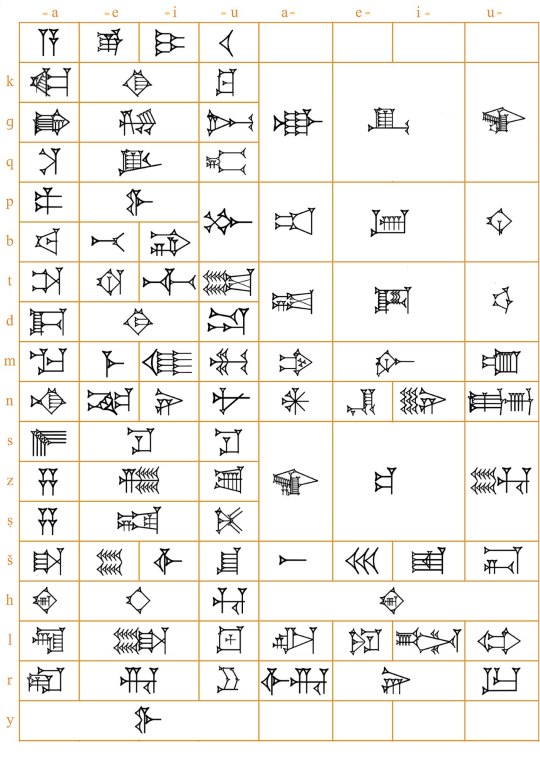
[image description: a Sumero-Akkadian cuneiform syllabary, used by early Akkadian rulers. It is a grid that has English letters on the top and left axis and shows the corresponding cuneiform characters]
I liked the visual similarities—both runes and cuneiform have very geometric, angular characters; both are written on materials that have been preserved really well—but then I wanted to make a reference sheet for myself, so I didn't have to keep on going to D&D Beyond to look up information. So I went on Canva and looked for a sufficiently angular and blocky font until I found a font called Obra Letra and made my reference sheet.

[image description: The first page of my reference sheet. It has brown angular text on a parchment background. The text has information from Tasha's Cauldron of Everything about the Artficer D&D class]
And then I got annoyed with Canva, switched to the Affinity suite of design programs, and Googled Obra Letra to see if I would be able to buy the font. And then I found out that it was inspired by vintage Filipino typography! Which is super cool!
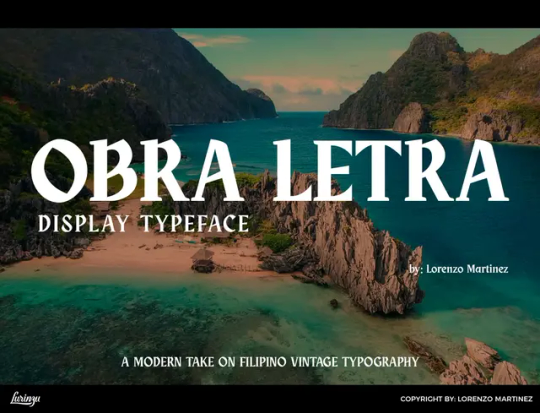
[image description: Text over an image of a bay in the Philippines. The text reads "Obra Letra Display Typeface by Lorenzo Martinez; a modern take on filipino vintage typography"]
And I currently have this document of of spells that my character can pick from, but I've been debating whether or not I use Obra Letra as the only font for all of it, or if I should find a different one for the body text and just use Obra Letra as like the font for like the spell names and stuff.

[image description: The first page of my spell description document. There is brown angular text over a parchment background. The text includes the spell information for the spells "Prestidigitation" and "Mage Hand"]
So I Googled Filipino inspired fonts, just going off of the description of Obra Letra, and found an article from Canva of Filipino inspired fonts! And then I was like, “Well, these are all like, display fonts and not quite what I'm looking for…What if I google Vietnamese inspired fonts!” And I found a website called vietnamesetypography.com that lists recommendations for fonts that can accommodate all of the tonal markings that Vietnamese has as well as resources for designing fonts with those markings in mind and a brief history of writing in Vietnam! Which is so cool!!
There’s probably a deeper conversation about Asian diaspora and being a second gen immigrant engaging with my family’s culture to be had here, but I’m just so dang excited that:
1. There’s no “right”way to worldbuild. Tolkien was a language nerd, so he built Middle Earth and all the cultures within to house the conlangs he was making. If you happen to be stuck with worldbuilding, start from the place that makes you excited to go down Wikipedia rabbit holes. I love calligraphy and typography, so that’s where I started.
2. That what you, or I create, or anyone creates will always have a part of them in it. And that when you’re able to bring all of yourself—your culture, your experience, your interests—what you create becomes even richer
9 notes
·
View notes
Note
Alright, your turn! If YOUR OCs starred in a movie, who would you pick to play them?
(I know you have a ton of OCs, feel free to just do the ones you can come up with a good answer for - I struggled to pick people for this and I have like half the OCs you do lol)
Alright so some of these people aren't actors or anything but they're definitely who I imagine the characters looking like-
Siv: Romy Flores, 100%. She's got the face, the nose, the "don't give a fuck" attitude. All she'd really need is gray contact lenses and either a haircut or a short wig.
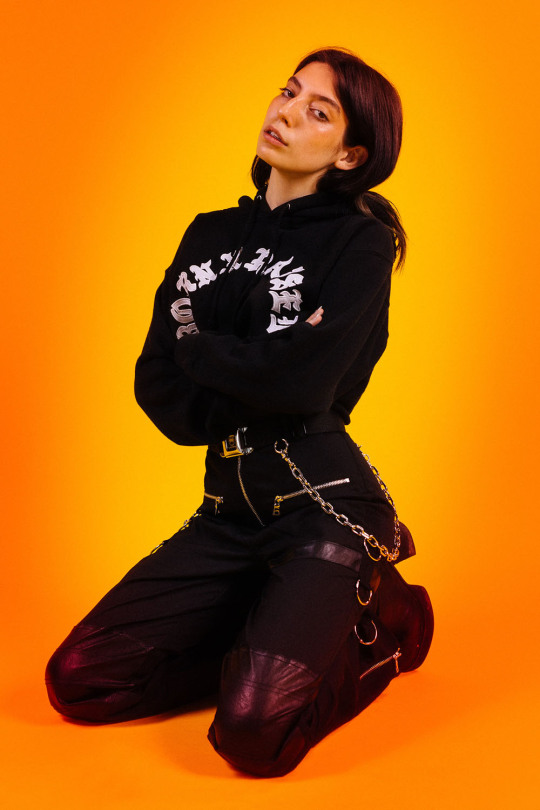
Hailey: Lynk Lee isn't 100% perfect for Hailey, since Hailey has a more stocky, muscular build, but in the hypothetical movie, if she were to do some weight training, she could definitely do Hailey justice. Also, she'd need green/blue contacts for Hailey's post-death heterochromatic eyes.

Jay: Elliot Fletcher is the closest I can get to how I imagine Jay looking, though I would hypothetically want to cast someone who was both transmasc and physically disabled, since Jay is both.

Cassandra: Halle is absolutely perfect for Cassandra- though if she were to play the role, she'd need violet contacts for Cassandra's magic-corrupted eyes.

Arya: Cayley Spivey, 100%! This, but with elf ears and a shaggy mullet! (fun fact: Spivey was the fancast for Siv's original design)

Esme: Ava Max is my current fancast for her. She's got the bleach blonde hair, the "party girl" vibe and the angular yet cutesy face.

Gina: Ilianna Ayala Garcia would make a pretty good Gina, imo, though she's a little older than the actual Gina was when she died, what movie doesn't have a 20-something playing a teen?

Ember: Marina Summers, a queen who starred in S1 of Drag Race Philippines, is absolutely perfect for Ember!

Cat: Even though she doesn't necessarily look entirely like Cat, I've never been able to imagine anyone but Anna Cathcart as her. I think its just the vibes lol.

Kyle: This random-ass hockey player from Minnesota, Ryan Johnson, has been my faceclaim for Kyle since I first created the character.

Max: Heng Sokvisal makes a pretty good Max, just slap on a pair of glasses and we're good to go!

Khalil: Shameik Moore makes the perfect Khalil imo. No comments, just vibes. (though since Khalil works as a makeup artist I'd definitely give him some gold eyeliner or something)

Reggie: Winnie Harlow's pretty much perfect for Reggie, though she'd need blue contacts because Reggie has xer dad's eyes.

Ameerah: Amandla Stenberg makes an absolutely amazing Ameerah, I'd definitely want her to have the light blonde hair like in the picture, and she'd need pink contacts to match Ameerah's description.

Rania: Denise Bidot, 10000000%. She's been my faceclaim for her for like, FOREVER.

Director Hawke: Julianne Moore, specifically in her "President Coin" look. Director Hawke was loosely based on President Coin, so I've always imagined her looking somewhat like her.

Meredith: Rachel Zegler, but with glasses and lighter brown hair.

Onnie: Same as Siv lol it's her multiversal variant
Jessi: Same as Esme, multiversal variant
Pippa: Veondre Mitchell is the perfect Pippa! She was actually the one who I initially based Pippa's appearance off of.

Hyun-Ki: Park Sung-Hoon is a pretty good Hyun-Ki. From his dramatic looks to his honestly kinda gorgeous voice. I don't doubt he'd make a great Hyun-Ki

Thalia: Teyonah Parris is Thalia, there's no doubt about it. Ever since I watched Wandavision and saw her as Monica Rambeau, I knew that she'd be perfect to play Thalia in her hypothetical movie.

Reyna: K-Pop soloist AleXa is a pretty good fancast for her, though she'd need some pretty good SFX makeup or CGI due to Reyna being a near-human felid species.

Athena: Alaqua Cox (AKA Echo from Hawkeye) is how I imagine Athena looks, but with a white streak in the front of her hair (and a lot more seductive of an aesthetic)

Laila: Youtuber Beth Crowley is my faceclaim for Laila, though as Laila I'd want her to either don a short bob or a short wig, and amber contacts.

Marie: Mayu Maeshima is a great faceclaim for Marie, though she'd need SFX makeup for Marie's Romulan features and her Borg implants.

Qiara: Due to Qiara's nature as a being of pure energy, she doesn't necessarily take the same form at all times. However, the one she frequents the most could very well be portrayed by Chiquis Rivera.

Liah: Raquel Rodriguez would make a great Liah, she has the right height and build for her, she would just need SFX makeup for Liah's Cardassian features, and hazel contacts.

Samira: Desiree Akhavan would make a pretty good Samira. She definitely fits how I imagine Samira to look, and she's got the right vibe to play her as well.

Sohelia: Golshifteh Farahani is a pretty good faceclaim for Sohelia, though she'd need some light makeup to make her skin more ashy, due to Sohelia being half-vampire.

Vanessa: Storm Reid is absolutely perfect for Vanessa, though for most of the movie she'd be replaced with either a puppet or CGI double for her monster form.

Dolores: Diane Guerrero is perfect for Dolores. She'd just need some minor makeup in order to look more like a vampire, i.e. ashy skin, red eyes, fangs, etc.

I don't have faceclaims for Eric, Jacob, Antonio, Cory, Soraya, Aldrich, Matt, or Victorie yet.
12 notes
·
View notes
Text
Automotive Multi Axis Positions Sensors Market Size, Share, Trends, Opportunities, Key Drivers and Growth Prospectus
Global Automotive Multi Axis Positions Sensors Market – Industry Trends and Forecast to 2029
Global Automotive Multi Axis Positions Sensors Market, By Sales Channel (Original Equipment Manufacturer, Aftermarket), Vehicle Type (High End, Mid End, Low End, Electric), Type (Multi-Axis, Angular, Linear, Chasis, Powertrain, Vehicle Body and Others), End-user (Passenger Vehicle, Commercial Vehicle), Application (Engine, Power Transmission, Gear Box, Steering and Pedals, Others), Country (U.S., Canada, Mexico, Brazil, Argentina, Rest of South America, Germany, Italy, U.K., France, Spain, Netherlands, Belgium, Switzerland, Turkey, Russia, Rest of Europe, Japan, China, India, South Korea, Australia, Singapore, Malaysia, Thailand, Indonesia, Philippines, Rest of Asia Pacific, South Africa, Saudi Arabia, U.A.E, Israel, Egypt, Rest of Middle East and Africa) Industry Trends and Forecast to 2029
Access Full 350 Pages PDF Report @
**Segments**
- **Type**: The automotive multi-axis position sensors market can be segmented based on the type of sensors, which include MEMS, magnetostrictive, optical, resistive, and others. MEMS sensors are expected to dominate the market due to their compact size, high precision, and cost-effectiveness. - **Vehicle Type**: Segmentation based on vehicle type includes passenger cars, commercial vehicles, and electric vehicles. With the rise in electric vehicle adoption, the demand for multi-axis position sensors in this segment is expected to witness significant growth. - **Application**: Automotive multi-axis position sensors find applications in various systems such as powertrain, chassis, safety systems, and others. The increasing focus on vehicle safety and performance is driving the demand for these sensors across different applications. - **Sales Channel**: The market can also be segmented based on the sales channels, including OEMs and aftermarket. OEMs are expected to hold a larger market share due to the integration of advanced sensor technologies in new vehicles.
**Market Players**
- **TE Connectivity** - **Continental AG** - **Allegro MicroSystems, LLC** - **Bourns, Inc.** - **CTS Corporation** - **Analog Devices, Inc.** - **Infineon Technologies AG** - **Novotech Inc.** - **Sensata Technologies, Inc.** - **Stoneridge, Inc.**
The global automotive multi-axis position sensors market is witnessing significant growth due to the increasing adoption of advanced safety and driver assistance systems in vehicles. This market analysis report provides insights into the key segments shaping the industry. The type segment, including MEMS, magnetostrictive, optical, resistive, and others, caters to different requirements in terms of precision and reliability. Vehicle type segmentation covering passenger cars, commercial vehicles, and electric vehicles reflects the evolving automotive landscape towards sustainability and technological innovation.
The application segment highlights the diverse use of multi-axis position sensors in powertrain, chassis, safety systems, and other automotive applications. As vehicles become more connected and autonomous, the demand for precise position sensing in critical systems continues to grow. Moreover, the sales channel segmentation between OEMs and aftermarket showcases the distribution channels through which these sensors reach end consumers. OEMs play a crucial role in integrating advanced sensor technologies, driving market growth through new vehicle installations.
Key market players such as TE Connectivity, Continental AG, Allegro MicroSystems, LLC, Bourns, Inc., and others are actively involved in product development and strategic collaborations to enhance their market presence. These companies focus on technological advancements, product innovation, and expanding their global footprint to cater to the growing demand for automotive multi-axis position sensors. The competitive landscape of the market is characterized by a mix of established players and emerging companies striving to capture a larger market share.
https://www.databridgemarketresearch.com/reports/global-automotive-multi-axis-positions-sensors-marketThe global automotive multi-axis position sensors market is undergoing a significant transformation driven by technological advancements and the increasing focus on vehicle safety and performance. One key trend shaping this market is the shift towards electric vehicles, influencing the demand for sensors that can enhance efficiency and accuracy in various automotive applications. This surge in electric vehicle adoption is propelling the growth of multi-axis position sensors tailored for this segment, presenting lucrative opportunities for market players to innovate and cater to evolving industry needs.
Moreover, the application segment of automotive multi-axis position sensors is crucial in understanding the diverse utility of these sensors across different systems within vehicles. The emphasis on powertrain, chassis, and safety systems underscores the vital role these sensors play in ensuring optimal vehicle performance, driving dynamics, and overall safety standards. As automotive technology continues to evolve towards autonomous driving and connected vehicles, the demand for high-precision position sensing in critical applications is expected to escalate, creating a favorable environment for market expansion and innovation.
Furthermore, the segmentation based on sales channels between OEMs and aftermarket sheds light on the distribution dynamics within the automotive multi-axis position sensors market. OEMs hold a dominant position in this space, primarily due to their role in integrating advanced sensor technologies into new vehicles. Collaborations between OEMs and sensor manufacturers are key drivers of market growth, as they enable seamless integration of cutting-edge sensor solutions into next-generation vehicles, meeting consumer demand for enhanced safety and performance features.
In terms of market players, industry leaders such as TE Connectivity, Continental AG, Allegro MicroSystems, LLC, Bourns, Inc., and others are actively engaged in research and development initiatives to stay ahead in the competitive landscape. These key players are focusing on product innovation, strategic partnerships, and geographical expansion to bolster their market presence and address the evolving needs of the automotive sector. Leveraging their expertise in sensor technologies, these companies are poised to capitalize on the growing demand for automotive multi-axis position sensors and establish themselves as key stakeholders in this dynamic market.
Overall, the global automotive multi-axis position sensors market presents a promising outlook driven by factors such as technological advancements, the proliferation of electric vehicles, and the increasing emphasis on safety and performance in vehicles. With a diverse range of applications and a competitive landscape characterized by innovation and collaboration, this market is set to witness continued growth and evolution as automotive technology continues to advance towards a more connected and automated future.**Segments**
- Global Automotive Multi Axis Positions Sensors Market, By Sales Channel (Original Equipment Manufacturer, Aftermarket), Vehicle Type (High End, Mid End, Low End, Electric), Type (Multi-Axis, Angular, Linear, Chasis, Powertrain, Vehicle Body and Others), End-user (Passenger Vehicle, Commercial Vehicle), Application (Engine, Power Transmission, Gear Box, Steering and Pedals, Others), Country (U.S., Canada, Mexico, Brazil, Argentina, Rest of South America, Germany, Italy, U.K., France, Spain, Netherlands, Belgium, Switzerland, Turkey, Russia, Rest of Europe, Japan, China, India, South Korea, Australia, Singapore, Malaysia, Thailand, Indonesia, Philippines, Rest of Asia Pacific, South Africa, Saudi Arabia, U.A.E, Israel, Egypt, Rest of Middle East and Africa) Industry Trends and Forecast to 2029
The automotive multi-axis position sensors market is witnessing substantial growth driven by advancements in safety and driver assistance systems. The segmentation based on sales channels, including Original Equipment Manufacturer (OEM) and Aftermarket, underlines the distribution dynamics within the market. OEMs are poised to maintain a dominant position by incorporating cutting-edge sensor technologies into new vehicles, fostering collaborations with sensor manufacturers and meeting consumer demands for enhanced safety and performance features.
The segmentation by vehicle type, categorizing vehicles into High End, Mid End, Low End, and Electric, reflects the evolving automotive landscape towards sustainability and technological innovation. With the increasing adoption of electric vehicles, the demand for multi-axis position sensors tailored for this segment is expected to grow significantly. Manufacturers are focusing on developing sensors that enhance efficiency and accuracy in various automotive applications, aligning with the shift towards electric propulsion technologies.
The segmentation by type, covering Multi-Axis, Angular, Linear, Chassis, Powertrain, Vehicle Body, and Others, showcases the diverse requirements in terms of precision and reliability met by different sensor types. These sensors play a crucial role in various applications such as Engine, Power Transmission, Gear Box, Steering and Pedals, among others, highlighting their significance in ensuring optimal vehicle performance and safety standards. As vehicles become more connected and autonomous, the demand for high-precision position sensing in critical applications is expected to rise.
The industry trends and forecast to 2029 suggest a promising outlook for the global automotive multi-axis position sensors market. Factors such as technological advancements, the proliferation of electric vehicles, and the increasing emphasis on safety and performance in vehicles are driving market growth. Key market players like TE Connectivity, Continental AG, Allegro MicroSystems, LLC, and others are actively engaged in research and development initiatives to stay competitive. By focusing on product innovation, strategic partnerships, and geographical expansion, these players aim to cater to the evolving needs of the automotive sector and establish themselves as key stakeholders in the dynamic market landscape.
Table of Content:
Part 01: Executive Summary
Part 02: Scope of the Report
Part 03: Global Automotive Multi Axis Positions Sensors Market Landscape
Part 04: Global Automotive Multi Axis Positions Sensors Market Sizing
Part 05: Global Automotive Multi Axis Positions Sensors Market Segmentation By Product
Part 06: Five Forces Analysis
Part 07: Customer Landscape
Part 08: Geographic Landscape
Part 09: Decision Framework
Part 10: Drivers and Challenges
Part 11: Market Trends
Part 12: Vendor Landscape
Part 13: Vendor Analysis
Key takeaways from the Automotive Multi Axis Positions Sensors Market report:
Detailed considerate of Automotive Multi Axis Positions Sensors Market-particular drivers, Trends, constraints, Restraints, Opportunities and major micro markets.
Comprehensive valuation of all prospects and threat in the
In depth study of industry strategies for growth of the Automotive Multi Axis Positions Sensors Market-leading players.
Automotive Multi Axis Positions Sensors Market latest innovations and major procedures.
Favorable dip inside Vigorous high-tech and market latest trends remarkable the Market.
Conclusive study about the growth conspiracy of Automotive Multi Axis Positions Sensors Market for forthcoming years.
Browse Trending Reports:
Potassium Tetrafluoroborate Market Flight Data Recorder Market Spinal Devices And Biologics Market Automotive Radiator Fan Market Poultry Growth Promoters And Performance Enhancers Market Tax And Accounting Software Market Taurodontism Treatment Market Antivirus Software Market Irrigation Pumps Market Rigid Transparent Plastics In Medical Application Market Liquefied Natural Gas Lng Carrier Market Leukapheresis Devices Market Rock Salt Market Ortho Pediatric Devices Market Chronic Lymphocytic Leukemia Therapeutics Market Beer Processing Market Cord Blood And Cell Banking Market Amino Acids And Proteins For Animal Nutrition Market Digital Dose Inhaler Market Branded Generics Market
About Data Bridge Market Research:
Data Bridge set forth itself as an unconventional and neoteric Market research and consulting firm with unparalleled level of resilience and integrated approaches. We are determined to unearth the best market opportunities and foster efficient information for your business to thrive in the market. Data Bridge endeavors to provide appropriate solutions to the complex business challenges and initiates an effortless decision-making process.
Contact Us:
Data Bridge Market Research
US: +1 614 591 3140
UK: +44 845 154 9652
APAC : +653 1251 975
Email: [email protected]
0 notes
Text
🌍 Popular Locations to set up an ODC in 2025
When establishing an Offshore Development Center (ODC), location is important. Discover which region fits your goals and why these hotspots are leading the offshore development trend. Here's an overview of popular regions:
1. Asia-Pacific: Cost-Effective & Skilled Talent
Vietnam 🇻🇳: The Rising Star
* Cost: Highly competitive (30-50% lower than Western Europe/US).
* Talent: Strong software engineering skills, growing tech ecosystem.
* Tech Stacks: Java, JavaScript, C#/.NET, Python, Go.
* Time Zone: UTC+7.
* Pros: Tax incentives, growing startup scene.
* Cons: Potential communication challenges.
India 🇮🇳: The Largest IT Hub
* Cost: Competitive but rising in major cities.
* Talent: Vast developer pool, strong SaaS industry.
* Tech Stacks: MongoDB, Express.js, React.js, Node.js, Java, C#.
* Time Zone: UTC+5:30.
* Pros: Well-developed tech parks, strong connectivity.
* Cons: Time zone differences, rising salaries.
Philippines 🇵🇭: Customer Support & IT Services
* Cost: Lower than India and Vietnam.
* Talent: Strong English proficiency, established IT infrastructure.
* Tech Stacks: Linux, PHP, Python, MongoDB, Express.js, Angular, Node.js.
* Time Zone: UTC+8:00.
* Pros: High English proficiency.
* Cons: Limited AI/blockchain expertise, BPO focus.
2. Eastern Europe: Strong Tech Talent & EU Compliance
Ukraine 🇺🇦:
* Cost: Higher than Asia.
* Talent: Strong technical skills.
* Tech Stacks: Linux, PHP, Python, JavaScript, MongoDB, .NET.
* Time Zone: UTC+3.
* Pros: Strong tech talent.
* Cons: Geopolitical instability, higher costs.
Poland 🇵🇱: EU-Based Companies
* Cost: Higher than Asia.
* Talent: Access to EU market, strong fintech innovation.
* Tech Stacks: Python, Java, JavaScript, C#, C++, PHP, .NET.
* Time Zone: UTC+2.
* Pros: EU compliance, strong talent pool.
* Cons: Higher costs.
3. Latin America: Best for US-Based Companies
Mexico 🇲🇽: Proximity & Cost-Effectiveness
* Cost: Mid-range.
* Talent: Growing IT sector, good for nearshore/onshore projects.
* Tech Stacks: Python, Java, JavaScript, Ruby on Rails, .NET.
* Time Zone: UTC-6.
* Pros: Proximity to the US, overlapping work hours.
* Cons: Higher costs than some Asian countries.
Brazil 🇧🇷: Largest IT Market in Latin America
* Cost: Mid-range.
* Talent: Strong AI/ML development, large English-speaking workforce.
* Tech Stacks: Python, JavaScript, Kotlin, Ruby on Rails, PHP, Java.
* Time Zone: UTC-3.
* Pros: Large IT market, strong AI/ML capabilities.
* Cons: Complex tax systems.
Choosing the right ODC location requires careful consideration of your specific needs and priorities.
🔗 Check out the full article here: https://saigontechnology.com/blog/offshore-development-center/

#SaigonTechnology#OffshoreDevelopmentCenter#ODC#Vietnam#India#Philippines#EasternEurope#LatinAmerica
0 notes
Text

“MADONNA OF THE SLUMS”
by Vicente Manansala
“Madonna of the Slums” is a significant artwork by Vicente Manansala, created in 1950. This painting, done in oil on canvas, the word "Madonna" was meant more to remind people of the theological concept which is placing such a high value on purity or virginity, in a setting that reflects urban poverty, symbolizing the strength and love of a mother in difficult times. The title speaks to the contrast between religious devotion and the everyday struggles faced by those living in slums, highlighting the resilience found in maternal care. Manansala, a celebrated Filipino artist known for his unique Cubist style, sought to capture the realities of life for marginalized communities through his work. Today, ”Madonna of the Slums” is part of the collection at the Cultural Center of the Philippines, where it continues to inspire viewers and provoke thought about faith, compassion, and social justice. This artwork serves as a reminder of the enduring spirit of humanity amidst hardship.
“Madonna of the Slums” features a mother and child, symbolizing themes of vulnerability and resilience. The mother’s wary expression reflects her awareness of their harsh surroundings, while the child’s upward reach emphasizes their protective bond. The background, filled with makeshift houses constructed from leftover materials and adorned with patchwork roofs, underscores the dire living conditions and pervasive sense of overcrowding. The visible dirt and grime enhance the scene’s realism. The artist employs geometric shapes to construct both the figures and the houses, creating a dynamic composition that invites viewers to engage with the artwork from multiple angles. This technique amplifies the chaotic atmosphere of the slum. A predominantly brown color palette imparts a somber tone, evoking feelings of struggle and hardship. Utilizing oil paint-a medium known for its texture and depth- the artist enriches the visual experience. The cubist style, characterized by geometric forms and multiple viewpoints, effectively captures the chaos of slum life while preserving the integrity of the human figures. This approach powerfully articulates the experiences of the urban poor, making a poignant statement about their lives.
In “Madonna of the Slums,” various formal elements intricately interconnect to enhance the subject matter and overall impact of the piece. The predominant use of earthy browns establishes. Somber tone that mirrors the struggles a of the urban poor, while subtle variations in hue provide depth, suggesting the complexities of their lives. Geometric shapes dominate the composition, forming both the human figures and the makeshift houses, this angularity contributes to a sense of fragmentation and chaos, reflecting the instability of the environment. The interplay of direction-where the child’s upward reach contrasts with the mother’s downward gaze creates dynamic tension, emphasizing their protective bond and guiding the viewer’s eye through the scene. Layering and overlapping shapes create dimensionality, drawing the viewer into the crowded setting, while the cubist style’s multiple viewpoints reflect the chaotic nature of slum life. Repetition of geometric forms establishes a visual rhythm that reinforces the interconnected hardships faced by the figures. Overall, the work captures the tension between despair and resilience, effectively delivering a poignant commentary on vulnerability, strength, and the harsh realities of urban poverty
“Madonna of the Slums” serves as a deep reflection on the human experience, illustrating the themes of vulnerability and resilience within urban poverty. This artwork is a key example of the Cubist movement, which arose in the early 20th century, particularly between 1907 and 1914, and is defined by its geometric shapes and multiple perspectives. The artist’s use of cubism captures the chaotic and fragmented nature of slum life, challenging traditional portrayals of motherhood by placing it in a harsh context. The central figures of the mother and child symbolize the strength of family ties while acknowledging their difficult reality. The mother’s cautious expression, paired with the child’s upward reach, highlights the balance of protection and vulnerability, suggesting that love can thrive even in adversity. This dynamic is emphasized by the geometric shapes that construct both the figures and their makeshift homes, showcasing the instability of their environment and the mix of community and chaos in their lives. The muted, earthy color scheme enhances the serious tone of the piece, reflecting the emotional burden of their experiences. The repetition of geometric forms and the layering of shapes create a visual rhythm that echoes the ongoing hardships of slum life. This abstract approach invites viewers to connect emotionally with the subjects, reinforcing that their struggles are collective rather than isolated. The artist’s engagement with Cubism may have been shaped by the socio-political context of the early 20th century, characterized by rapid urbanization and industrialization that heightened social inequalities. By portraying the marginalized in this innovative style, the artist aims to elevate their story, turning them from simple depictions of poverty into powerful symbols of resilience.
In evaluating “Madonna of the Slums, the craftsmanship and technique are impressive. The artist skillfully uses geometric shapes to create both the figures and the surrounding environment, showing a strong understanding of form and space. The way these elements work together is effective, reflecting the chaos of slum life. The emotional impact of the work is significant; the expressions on the mother and child evoke feelings of empathy and reflection. The artwork conveys a powerful message about resilience in difficult circumstances, making a strong statement about the struggles faced by the urban poor. Personally, I find this piece moving because it tells a deep story about human experience. Aesthetically, the muted colors and rhythmic shapes make the artwork visually striking. These choices enhance the emotional weight of the piece and help ground the viewer in the harsh realities depicted. My judgment is based on how well the technique and meaning are combined, as well as the feelings it inspires. Overall, “Madonna of the Slums is a powerful artwork that deserves recognition for its artistic quality and social message.
In conclusion, “Madonna of the Slums” is a powerful artwork that highlights the themes of vulnerability and resilience in urban poverty. Using cubist techniques, the artist captures the chaotic life in the slums while emphasizing the bond between the mother and child. The geometric shapes and earthy colors create a strong emotional impact, inviting viewers to connect with their struggles. This piece not only showcases artistic skill but also offers a meaningful commentary on the lives of the marginalized, making it an important work in both art and social discussions.
0 notes
Text
Easy "Hello World" Introduction to Angular Framework
Creating a “Hello World” application in Angular is a great way to get started with this popular JavaScript framework. Here’s a step-by-step tutorial to help you build your first Angular app: Prerequisites:Before you begin, make sure you have Node.js and npm (Node Package Manager) installed on your system. You can download and install them from the official website: https://nodejs.org/ Step 1:…

View On WordPress
#angular developer philippines#angular framework#angular programming philippines#hello world angular#introduction to angular
0 notes
Text
Corner Post Edge Protectors Market Market Analysis: Understanding Trends and Dynamics by 2032
New Research Report on ��Corner Post Edge Protectors Market Market” provide insightful data on the main market segments, dynamics, growth potentials and future prospects of industry. The study covers complete analysis on changing market trends for industry. The report shows the year-on-year growth of each segment and touches upon the different factors that are likely to impact the growth of each market segment. Each segment has analyzed completely on the basis of its production, consumption as well as revenue. And also offers Corner Post Edge Protectors Market market size and share of each separate segment in the industry.
Get a Sample Copy of the Report at - https://www.proficientmarketinsights.com/enquiry/request-sample/1304
The global corner post edge protectors market size was USD 401 million in 2024 and the market is projected to touch USD 575.6 million by 2031, exhibiting a CAGR of 5.4% during the forecast period.
Top Key Players in the Corner Post Edge Protectors Market Market:
Sonoco (U.S.)
RDR Packaging (U.K.)
IPS (U.K.)
Rajapack (India)
NAL Company (U.K.)
Request Sample for Covid-19 Impact Analysis - https://www.proficientmarketinsights.com/enquiry/request-covid19/1304
The Corner Post Edge Protectors Market market research report presents a comprehensive assessment of the market and contains thoughtful insights, facts, historical data, and statistically supported and industry-validated market data. It also contains projections using a suitable set of assumptions and methodologies. The research report provides analysis and information according to market segments such as geographies, application, and industry.
Market split by Type, can be divided into:
Angular Type
Round Type
Market split by Application, can be divided into:
Food and Beverage
Building Materials
Personal Care and Cosmetics
Pharmaceutical
Electrical and Electronics
Chemicals
Others
Report presents a detailed picture of the market by the way of study, synthesis, and summation of data from multiple sources by an analysis of key parameters. Our Corner Post Edge Protectors Market market covers the following areas:
Corner Post Edge Protectors Market market sizing
Corner Post Edge Protectors Market market forecast
Corner Post Edge Protectors Market market industry analysis
Inquire or Share Your Questions If Any Before the Purchasing This Report -https://www.proficientmarketinsights.com/enquiry/pre-order-enquiry/1304
What Global Corner Post Edge Protectors Market Market Report Offers?
Provides strategic profiling of key players in the Corner Post Edge Protectors Market market.
Drawing a competitive landscape for the world Corner Post Edge Protectors Market industry.
Describes insights about factors affecting the Corner Post Edge Protectors Market market growth.
Analyze the Corner Post Edge Protectors Market industry share based on various factors- price analysis, supply chain analysis etc.
Extensive analysis of the industry structure along with Corner Post Edge Protectors Market market forecast 2020-2024.
Granular Analysis with respect to the current Corner Post Edge Protectors Market industry size and future perspective.
Regions Covered in Corner Post Edge Protectors Market Market Report:
North America (United States, Canada and Mexico)
Europe (Germany, UK, France, Italy, Russia and Turkey etc.)
Asia-Pacific (China, Japan, Korea, India, Australia, Indonesia, Thailand, Philippines, Malaysia and Vietnam)
South America (Brazil etc.)
Middle East and Africa (Egypt and GCC Countries)
Purchase this Report (Price 2900 USD for a Single-User License) - https://www.proficientmarketinsights.com/purchase/1304
0 notes
Text
Corner Post Edge Protectors Market Market Analysis: Understanding Trends and Dynamics by 2032
New Research Report on “Corner Post Edge Protectors Market Market” provide insightful data on the main market segments, dynamics, growth potentials and future prospects of industry. The study covers complete analysis on changing market trends for industry. The report shows the year-on-year growth of each segment and touches upon the different factors that are likely to impact the growth of each market segment. Each segment has analyzed completely on the basis of its production, consumption as well as revenue. And also offers Corner Post Edge Protectors Market market size and share of each separate segment in the industry.
Get a Sample Copy of the Report at - https://www.proficientmarketinsights.com/enquiry/request-sample/1304
The global corner post edge protectors market size was USD 401 million in 2024 and the market is projected to touch USD 575.6 million by 2031, exhibiting a CAGR of 5.4% during the forecast period.
Top Key Players in the Corner Post Edge Protectors Market Market:
Sonoco (U.S.)
RDR Packaging (U.K.)
IPS (U.K.)
Rajapack (India)
NAL Company (U.K.)
Request Sample for Covid-19 Impact Analysis - https://www.proficientmarketinsights.com/enquiry/request-covid19/1304
The Corner Post Edge Protectors Market market research report presents a comprehensive assessment of the market and contains thoughtful insights, facts, historical data, and statistically supported and industry-validated market data. It also contains projections using a suitable set of assumptions and methodologies. The research report provides analysis and information according to market segments such as geographies, application, and industry.
Market split by Type, can be divided into:
Angular Type
Round Type
Market split by Application, can be divided into:
Food and Beverage
Building Materials
Personal Care and Cosmetics
Pharmaceutical
Electrical and Electronics
Chemicals
Others
Report presents a detailed picture of the market by the way of study, synthesis, and summation of data from multiple sources by an analysis of key parameters. Our Corner Post Edge Protectors Market market covers the following areas:
Corner Post Edge Protectors Market market sizing
Corner Post Edge Protectors Market market forecast
Corner Post Edge Protectors Market market industry analysis
Inquire or Share Your Questions If Any Before the Purchasing This Report -https://www.proficientmarketinsights.com/enquiry/pre-order-enquiry/1304
What Global Corner Post Edge Protectors Market Market Report Offers?
Provides strategic profiling of key players in the Corner Post Edge Protectors Market market.
Drawing a competitive landscape for the world Corner Post Edge Protectors Market industry.
Describes insights about factors affecting the Corner Post Edge Protectors Market market growth.
Analyze the Corner Post Edge Protectors Market industry share based on various factors- price analysis, supply chain analysis etc.
Extensive analysis of the industry structure along with Corner Post Edge Protectors Market market forecast 2020-2024.
Granular Analysis with respect to the current Corner Post Edge Protectors Market industry size and future perspective.
Regions Covered in Corner Post Edge Protectors Market Market Report:
North America (United States, Canada and Mexico)
Europe (Germany, UK, France, Italy, Russia and Turkey etc.)
Asia-Pacific (China, Japan, Korea, India, Australia, Indonesia, Thailand, Philippines, Malaysia and Vietnam)
South America (Brazil etc.)
Middle East and Africa (Egypt and GCC Countries)
Purchase this Report (Price 2900 USD for a Single-User License) - https://www.proficientmarketinsights.com/purchase/1304
0 notes
Text
Corner Post Edge Protectors Market Market Analysis: Understanding Trends and Dynamics by 2032
New Research Report on “Corner Post Edge Protectors Market Market” provide insightful data on the main market segments, dynamics, growth potentials and future prospects of industry. The study covers complete analysis on changing market trends for industry. The report shows the year-on-year growth of each segment and touches upon the different factors that are likely to impact the growth of each market segment. Each segment has analyzed completely on the basis of its production, consumption as well as revenue. And also offers Corner Post Edge Protectors Market market size and share of each separate segment in the industry.
Get a Sample Copy of the Report at - https://www.proficientmarketinsights.com/enquiry/request-sample/1304
The global corner post edge protectors market size was USD 401 million in 2024 and the market is projected to touch USD 575.6 million by 2031, exhibiting a CAGR of 5.4% during the forecast period.
Top Key Players in the Corner Post Edge Protectors Market Market:
Sonoco (U.S.)
RDR Packaging (U.K.)
IPS (U.K.)
Rajapack (India)
NAL Company (U.K.)
Request Sample for Covid-19 Impact Analysis - https://www.proficientmarketinsights.com/enquiry/request-covid19/1304
The Corner Post Edge Protectors Market market research report presents a comprehensive assessment of the market and contains thoughtful insights, facts, historical data, and statistically supported and industry-validated market data. It also contains projections using a suitable set of assumptions and methodologies. The research report provides analysis and information according to market segments such as geographies, application, and industry.
Market split by Type, can be divided into:
Angular Type
Round Type
Market split by Application, can be divided into:
Food and Beverage
Building Materials
Personal Care and Cosmetics
Pharmaceutical
Electrical and Electronics
Chemicals
Others
Report presents a detailed picture of the market by the way of study, synthesis, and summation of data from multiple sources by an analysis of key parameters. Our Corner Post Edge Protectors Market market covers the following areas:
Corner Post Edge Protectors Market market sizing
Corner Post Edge Protectors Market market forecast
Corner Post Edge Protectors Market market industry analysis
Inquire or Share Your Questions If Any Before the Purchasing This Report -https://www.proficientmarketinsights.com/enquiry/pre-order-enquiry/1304
What Global Corner Post Edge Protectors Market Market Report Offers?
Provides strategic profiling of key players in the Corner Post Edge Protectors Market market.
Drawing a competitive landscape for the world Corner Post Edge Protectors Market industry.
Describes insights about factors affecting the Corner Post Edge Protectors Market market growth.
Analyze the Corner Post Edge Protectors Market industry share based on various factors- price analysis, supply chain analysis etc.
Extensive analysis of the industry structure along with Corner Post Edge Protectors Market market forecast 2020-2024.
Granular Analysis with respect to the current Corner Post Edge Protectors Market industry size and future perspective.
Regions Covered in Corner Post Edge Protectors Market Market Report:
North America (United States, Canada and Mexico)
Europe (Germany, UK, France, Italy, Russia and Turkey etc.)
Asia-Pacific (China, Japan, Korea, India, Australia, Indonesia, Thailand, Philippines, Malaysia and Vietnam)
South America (Brazil etc.)
Middle East and Africa (Egypt and GCC Countries)
Purchase this Report (Price 2900 USD for a Single-User License) - https://www.proficientmarketinsights.com/purchase/1304
0 notes
Text
Industrial Sensors Market: Global Industry Analysis and Forecast 2023 – 2030

Industrial Sensors Market was valued at USD 23500 million in 2021 and is expected to reach USD 36280 million by the year 2028, at a CAGR of 6.4%.
Industrial sensors are devices that carries the main tasks of detecting events or changes in the environment and then providing the corresponding output. These sensors are used to sense input, such as light, heat, motion, pressure, moisture or any other entity, and respond by an output on a display or transmit the information in electronic form for further Processing of the information.
Industrial sensors are a key part of factory automation. Thoroughly, Industry 4.0. Motion, environmental, and vibration sensors are some of the sensors that are used to monitor the health of equipment, ranging from linear or angular positioning, tilt sensing, leveling, and shock, to fall detection.
Get Full PDF Sample Copy of Report: (Including Full TOC, List of Tables & Figures, Chart) @
https://introspectivemarketresearch.com/request/15857
The latest research on the Industrial Sensors market provides a comprehensive overview of the market for the years 2023 to 2030. It gives a comprehensive picture of the global Industrial Sensors industry, considering all significant industry trends, market dynamics, competitive landscape, and market analysis tools such as Porter's five forces analysis, Industry Value chain analysis, and PESTEL analysis of the Industrial Sensors market. Moreover, the report includes significant chapters such as Patent Analysis, Regulatory Framework, Technology Roadmap, BCG Matrix, Heat Map Analysis, Price Trend Analysis, and Investment Analysis which help to understand the market direction and movement in the current and upcoming years. The report is designed to help readers find information and make decisions that will help them grow their businesses. The study is written with a specific goal in mind: to give business insights and consultancy to help customers make smart business decisions and achieve long-term success in their particular market areas.
Leading players involved in the Industrial Sensors Market include:
Texas Instruments Incorporated, TE Connectivity Inc., Omega Engineering Inc., Honeywell International Inc., Rockwell Automation Inc., Siemens AG, STMicroelectronics Inc., ams AG, NXP Semiconductors NV, Omron Corporation other Major Players.
If You Have Any Query Industrial Sensors Market Report, Visit:
https://introspectivemarketresearch.com/inquiry/15857
Segmentation of Industrial Sensors Market:
By Sensing Type
Flow
Pressure
Proximity (Area)
Level Measurement
Temperature
Image
Others
By End-User Industry
Mining
Oil
and Gas
Manufacturing
Chemical
Pharmaceutical
Others
By Regions: -
North America (US, Canada, Mexico)
Eastern Europe (Bulgaria, The Czech Republic, Hungary, Poland, Romania, Rest of Eastern Europe)
Western Europe (Germany, UK, France, Netherlands, Italy, Russia, Spain, Rest of Western Europe)
Asia Pacific (China, India, Japan, South Korea, Malaysia, Thailand, Vietnam, The Philippines, Australia, New Zealand, Rest of APAC)
Middle East & Africa (Turkey, Bahrain, Kuwait, Saudi Arabia, Qatar, UAE, Israel, South Africa)
South America (Brazil, Argentina, Rest of SA)
What to Expect in Our Report?
(1) A complete section of the Industrial Sensors market report is dedicated for market dynamics, which include influence factors, market drivers, challenges, opportunities, and trends.
(2) Another broad section of the research study is reserved for regional analysis of the Industrial Sensors market where important regions and countries are assessed for their growth potential, consumption, market share, and other vital factors indicating their market growth.
(3) Players can use the competitive analysis provided in the report to build new strategies or fine-tune their existing ones to rise above market challenges and increase their share of the Industrial Sensors market.
(4) The report also discusses competitive situation and trends and sheds light on company expansions and merger and acquisition taking place in the Industrial Sensors market. Moreover, it brings to light the market concentration rate and market shares of top three and five players.
(5) Readers are provided with findings and conclusion of the research study provided in the Industrial Sensors Market report.
Our study encompasses major growth determinants and drivers, along with extensive segmentation areas. Through in-depth analysis of supply and sales channels, including upstream and downstream fundamentals, we present a complete market ecosystem.
If you require any specific information that is not covered currently within the scope of the report, we will provide the same as a part of the customization.
Acquire This Reports: -
https://introspectivemarketresearch.com/checkout/?user=1&_sid=15857
About us:
Introspective Market Research (introspectivemarketresearch.com) is a visionary research consulting firm dedicated to assisting our clients to grow and have a successful impact on the market. Our team at IMR is ready to assist our clients to flourish their business by offering strategies to gain success and monopoly in their respective fields. We are a global market research company, that specializes in using big data and advanced analytics to show the bigger picture of the market trends. We help our clients to think differently and build better tomorrow for all of us. We are a technology-driven research company, we analyse extremely large sets of data to discover deeper insights and provide conclusive consulting. We not only provide intelligence solutions, but we help our clients in how they can achieve their goals.
Contact us:
Introspective Market Research
3001 S King Drive,
Chicago, Illinois
60616 USA
Ph no: +1-773-382-1047
Email: [email protected]
#Industrial Sensors#Industrial Sensors Market#Industrial Sensors Market Size#Industrial Sensors Market Share#Industrial Sensors Market Growth#Industrial Sensors Market Trend#Industrial Sensors Market segment#Industrial Sensors Market Opportunity#Industrial Sensors Market Analysis 2023
0 notes
Text
Culture of the Philippines
The culture of the Philippines is characterized by cultural and ethnic diversity. Although the multiple ethnic groups of the Philippine archipelago have only recently established a shared Filipinonational identity, their cultures were all shaped by the geography and history of the region, and by centuries of interaction with neighboring cultures, and colonial powers. In more recent times, Filipino culture has also been influenced through its participation in the global community.
Ethnic groups of the Philippines
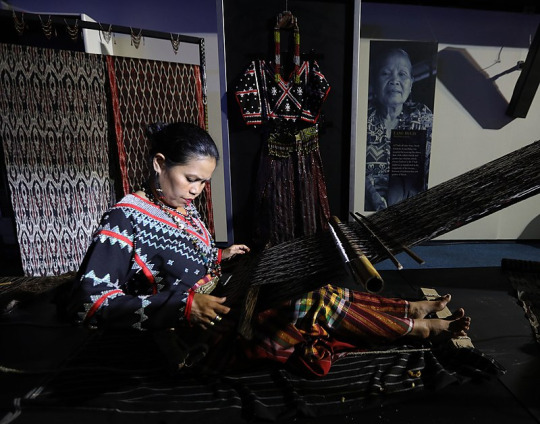
A Tboli woman weaving t'nalak from South Cotabato.
The Philippines is inhabited by more than 182 ethnolinguistic groups, many of which are classified as "Indigenous Peoples" under the country's Indigenous Peoples' Rights Act of 1997. Traditionally-Muslim peoples from the southernmost island group of Mindanao are usually categorized together as Moro peoples,
Architecture
Before the arrival of European colonizers, Austronesian architecture was the common form of housing on the archipelago.
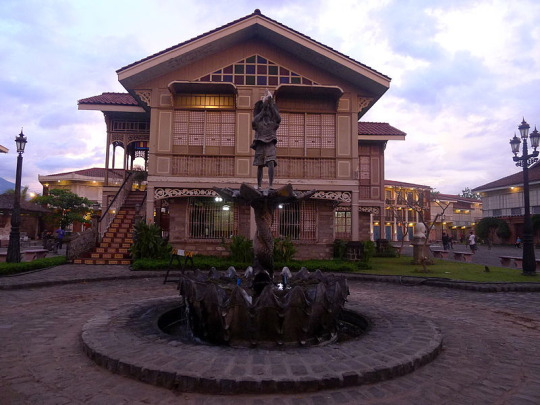
Bahay na bato, a traditional Filipino house
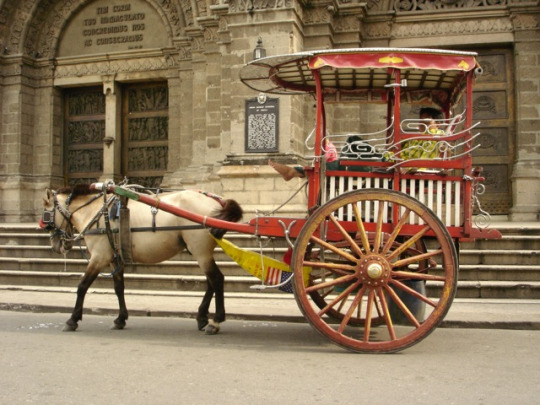
Kalesa, a traditional Philippine urban transportation, in front of Manila Cathedral entrance
During the Spanish era, the new Christianized lowland culture collectively evolved a new style known as the Nipa hut (Bahay Kubo). It is characterized by use of simple materials such as bamboo and coconut as the main sources of wood. Cogon grass, Nipa palm leaves and coconut fronds are used as roof thatching. Most primitive homes are built on stilts due to frequent flooding during the rainy seasons. Regional variations include the use of thicker, and denser roof thatching in mountain areas, or longer stilts on coastal areas particularly if the structure is built over water. The architecture of other indigenous peoples may be characterized by an angular wooden roofs, bamboo in place of leafy thatching and ornate wooden carvings. The Bahay na bato architecture is a variant of Nipa Hut that emerged during the Spanish era.
Traditional clothing
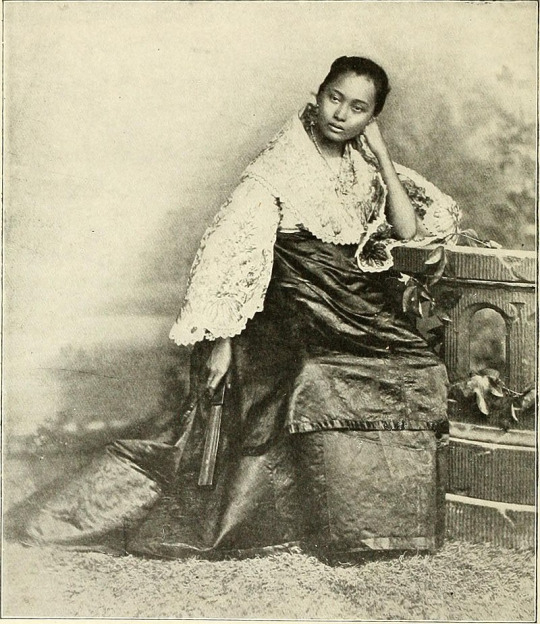
Filipina in traditional attire
Baro evolved from its forerunner garment worn by the Tagalogs of Luzon Prior to the Spanish Era. When the Spaniards came and settled into the islands, the fashion changed drastically as the Spanish culture influenced the succeeding centuries of Philippine history. The Spanish dissolved the kingdoms and united the country, resulting in a mixture of cultures from different ethnic groups of the conquered archipelago and Spanish culture. A new type of clothing called Barong tagalog (for men) and Baro't saya (for women) began to emerged and would ultimately define the newly formed Filipino culture....
Dancing

Filipino traditional dance at a festival
Philippine folk dances include the Tinikling and Cariñosa. In the southern region of Mindanao, Singkil is a popular dance showcasing the story of a prince and princess in the forest. Bamboo poles are arranged in a tic-tac-toe pattern in which the dancers exploit every position of these clashing poles
Music

Harana (serenade)
The early music of the Philippines featured a mixture of Indigenous, Islamic and a variety of Asian sounds that flourished before the European and American colonization in the 16th and 20th centuries. Spanish settlers and Filipinos played a variety of musical instruments, including flutes, guitar, ukulele, violin, trumpets and drums. They performed songs and dances to celebrate festive occasions....
Folklore
Philippine mythologies are the first literature of the Philippines, usually passed on through generation via traditional and oral folk literature. Written texts recording the stories have also been made. These literary stories are mostly chanted as part of a dynamic Philippine epic poetry. While each unique ethnic group has its own stories and myths to tell, Hindu and Spanish influences can nonetheless be detected in many cases. Philippine mythology mostly consists of creation stories or stories about supernatural creatures, such as the aswang, the manananggal, the diwata/engkanto, and nature. Some popular figures from Philippine mythologies are Makiling, Lam-Ang, and the Sarimanok
Religion

Original image of the Santo Niño de Cebú.
The arrival of the Spanish colonizers in the 16th century brought the beginning of the Christianization of the people in the Philippines. This phase in history is noted as the tipping point for the destruction of a variety of Anitist beliefs in the country, which were replaced by colonial belief systems that fitted the tastes of the Spanish, notably Christian beliefs. Christianity in form of has influenced Filipino culture in almost every facet, from visual arts, architecture, dance, and music. Presently, the Philippines is one of the two predominantly Catholic (80.58%) nations in Asia-Pacific, the other being East Timor. The country also has its own independent Philippine church, the Aglipayan, which accounts for around 2% of the national population. Other Christian churches are divided among a variety of Christian sects and cults. From the census in 2014, Christianity consisted of about 90.07% of the population and is largely present throughout the nation.....
Cuisine

Pancit canton
Filipinos cook a variety of foods influenced by of main Indian, Chinese, influences indigenous ingredients. The Spanish colonizers and friars in the 16th century brought with them produce from the Americas such as chili peppers, tomatoes, corn, potatoes, and the method of sautéing with garlic and onions. Eating out is a favorite Filipino pastime. A typical Pinoy diet consists at most of six meals a day; breakfast, snacks, lunch, snacks, dinner, and again a midnight snack before going to sleep. Rice is a staple in the Filipino diet, and is usually eaten together with other dishes. Filipinos regularly use spoons together with forks and knives. Some also eat with their hands, especially in informal settings, and also Filipinos use chopsticks when eating seafood....
Festivals

Flores de Mayo

Pahiyas Festival in Lucban Quezon

The MassKara Festival of Bacolod.
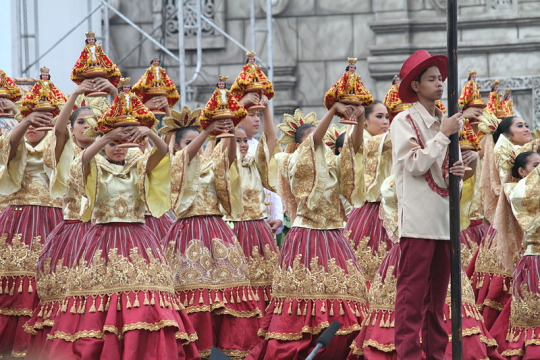
The Sinulog Festival is held to commemorate the Santo Niño
Festivals in the Philippines, locally known as fiestas, originated dating back to the Spanish colonial period when the Spaniards introduced Christianity to the country. Most Philippine towns and cities has a patron saint assigned to each of them. Fiestas in the Philippines serve as either religious, cultural, or both. These festivals are held to honor the patron saint or to commemorate history and culture, such as promoting local products and celebrate a bountiful harvest. Fiestas can be categorized by Holy Masses, processions, parades, theatrical play and reenactments, religious or cultural rituals, trade fairs, exhibits, concerts, pageants and various games and contests..
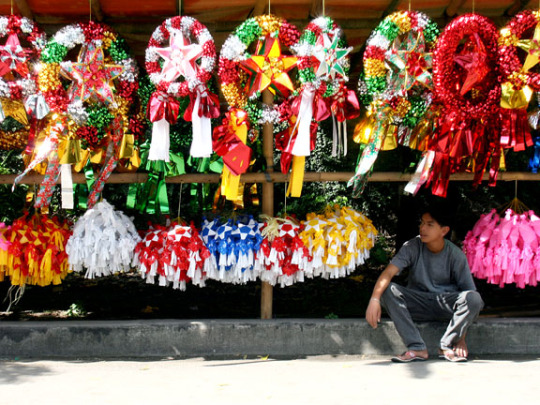
Parol (Christmas lanterns) being sold during the Christmas season

Good Friday observance in Pampanga
Heritage towns and cities
The Philippines is home to numerous heritage towns and cities, many of which have been intentionally destroyed by the Japanese through fire tactics in World War II and the Americans through bombings during the same war. After the war, the government of the Empire of Japan withheld from giving funds to the Philippines for the restoration of the heritage towns they destroyed, effectively destroying any chances of restoration since the pre-war Philippines' economy was devastated and had limited monetary supply. On the other hand, the United States gave minimal funding for only two of the hundreds of cities they destroyed, namely, Manila and Baguio....
Culture of the Philippines - Wikipedia

Ethnic Filipina in traditional costume
273 notes
·
View notes
Link
When Youk Chhang started writing letters to Zaha Hadid, it seemed like a quixotic mission. Chhang was beseeching the world’s most celebrated architect to help him build a genocide museum and research center in a small, wounded country. Eleven years later, books full of Dame Hadid’s designs for the center rest in his Phnom Pehn office, like precious secrets. Chhang has made significant strides in his quest, though the most important step remains.
The fact that Chhang made it to this point—that he even is alive—is a triumph. Like many other Cambodians from his generation, he suffered through horrors during the Khmer Rouge regime: He was tortured for picking mushrooms, and watched as his pregnant sister was cut open and killed under the suspicion that she had stolen rice. The teenager escaped to the Thai border in 1982, as fighting continued, then to the Philippines, and eventually the United States. He finally returned to Cambodia in 1992, where he worked as a UN election observer as the nation began to recover from over 20 years of genocide, brutality, and war.
A world away, Hadid was having a career breakthrough. Years after gaining attention in the architectural world for her creative designs, none of which were ever built, the architect finally found clients to realize them. Her first landmark building, an angular concrete fire station later used as an exhibit space, was completed in Germany in 1993, beginning a long run of success.
In 1995, Chhang became the director of the Documentation Center of Cambodia, or DC-Cam. In his time there, the nonprofit group dedicated to remembrance and reconciliation has GPS-mapped 20,000 mass graves, interviewed 10,000 victims and perpetrators, and collected more than a million documents about the genocide. DC-Cam’s work provided evidence for Khmer Rouge war crimes tribunals and helped Cambodia acknowledge the trauma it suffered through.
DC-Cam also created plans for a genocide center, dubbed the Sleuk Rith Institute, that would combine a museum, policy center, and school. The effort is as much about the future as the past. “It should be a place to heal, a place to commemorate. A beautiful place to look forward. We will turn a horrible past into a better future,” Chhang says. He wanted to break from the usual pattern of big genocide memorials around the world: depressing, heavy, and overwhelmingly male, both in terms of their sensibilities and who conceived them.
Chhang long dreamed of approaching Hadid to design Sleuk Rith, which means “the power of leaves,” referring to religious texts written on palm leaves, many of which were destroyed by the Khmer Rouge. Hadid had a record of making celebrated modern buildings with inventive, dramatic curves, and Chhang saw that as a way to break away from the sharp, masculine angles and doleful sensibility of many museums related to acts of genocide around the world. (When told that someone liked the U.S. Holocaust Museum in Washington, D.C., its designer, James Ingo Freed, was quoted in The New York Times saying, “You’re not supposed to like things like that. So I say: ‘Oh, yes, you did see it? Too bad for you, it was such an awful experience.’”) Hadid was born and raised in Iraq, and Chhang thought might help her understand Cambodia's situation, he says.
She also happened, by then, to be one of the most famous architects alive.
So Chhang, like a starry-eyed fan, began writing letters to the London office of Zaha Hadid Architects (ZHA), asking if she would consider designing the institute. The firm saw requests from people around the world and could only accept a tiny number of them, so Chhang turned up the charm. “I made her a birthday card with a picture of Angkor Wat. I sent her folktales from Cambodia and a story I heard from a woman in a small village,” he says. He implored her secretary to make sure his letters found their way to Hadid personally.
Eventually the architect invited Chhang to the firm’s London studio. He flew there by himself, stayed with a friend to save money, and met with Hadid and about 15 other architects. Impressed at the pitch, the firm accepted the project and sent a team to Cambodia to learn about the country to inform their work.
In 2014, after two years of work, the firm unveiled a design based on five intersecting “volumes,” or sections, each dedicated to one main function: a library holding DC-Cam’s documents, a graduate school on genocide and human rights, a research center to influence policy and discourse, a media center, and an auditorium. The primary building material is wood, which helps distinguish it from similar sites, usually made from stone, metal, and glass. “There was a deliberate intention not to follow a typical path of memorial architecture as it’s normally or historically expressed—the heavy austere monumentality that’s in some ways depressing,” says Craig Kiner, a senior associate at ZHA who helped lead the design process. “It’s much more light and uplifting and delicate, which is something we talked about at great length with Youk and the team. It represents tranquility and hope and healing—for everyone in Cambodia but also for everyone who visits the building,” he says.
Unfortunately, Hadid herself will never get to see the building realized. She died of a heart attack in 2016, leaving a grand legacy and a number of designs that, like the Sleuk Rith Institute, are yet to be completed.
DC-Cam is now trying to turn the striking plans into a real place. Raising money for construction is a central need, but it is one that Chhang reframes. “It’s not a question of cost. It’s a question of the principle of engagement. We want it to be for victims and survivors. They [developers] want it to be a business.” Chhang says that the developers he’s negotiating with want to put Sleuk Rith on a small property, but Chhang insists that it needs about 15 acres, so it has a peaceful environment. “I think it needs a landscape. For them a landscape is a waste of villas.”
It would be easy enough to find space for the institute in the countryside, but Chhang insists on it being in Phnom Penh, close to the country’s political center, accessible to everyone from Khmer Rouge victims to Cambodian officials to international leaders and tourists. Finding a big-enough plot within the city limits is an as-yet-unmet challenge. As for whether the institute will look suitably dignified in a bustling city going through an often chaotic development boom, Chhang is unworried. “When you are beautiful, it doesn’t matter what you wear,” he says. “I like competition. I’d like to see a nearby casino compete with Zaha’s design. Let’s see who’s the winner. I have complete trust over Zaha’s design.”
Chhang says he’s confident DC-Cam will reach an agreement with developers and funders and get the center built, possibly one “volume” at a time. “People have talked about Sleuk Rith costing $55 million or $65 million. But there were two million lives lost. The cost is almost nothing,” he says. Projects like this often take a decade or so, he says, and DC-Cam has put six years into realizing Sleuk Rith, though he declines to adopt a specific timeline. “We work on this every day. I work on the costs every day,” he says.
Kiner says ZHA is working with DC-Cam to smooth the building process. “It’s something that we’re very committed to delivering,” he says.
Though Hadid’s name and reputation attract a lot of interest from developers and the public, not everyone appreciates the center’s approach. “Like almost every project in Phnom Penh, these images simulate that the building rises majestically from the lower structures around, embedded in a lot of greenery,” says Moritz Henning, a Berlin-based architect who studies Cambodian postcolonial architecture and published a guide to Phnom Penh architecture last year. “Why does every project have to be unique, stand out from its surroundings, or better: rise above its surroundings?” he wrote in an email.
“For me, the architecture refers much more to religious buildings, to Gothic cathedrals (and in this respect it fits, people there also wanted to make people small) than to Cambodian architecture,” he says. “Please don’t misunderstand me, I’m not against the Sleuk Rith Institute. I think it would be great to have a place like this in Phnom Penh. But I’m very skeptical if this is the right way to go.”
Chhang sees the design-forward but still monumental approach as a way to draw the world’s attention to Cambodia and, likewise, connect the country with humanity as a whole. “The genocide center isn’t just about Cambodia. It’s about Armenia, Bosnia, Burma. That’s why I chose contemporary design, why I chose Zaha—to bring Cambodia out into the globe,” he says. “In Cambodia, there were lots of young girls like Anne Frank. There’s a lot of ways you can see the similarity. Why? Because we are all human beings.”
21 notes
·
View notes
Photo

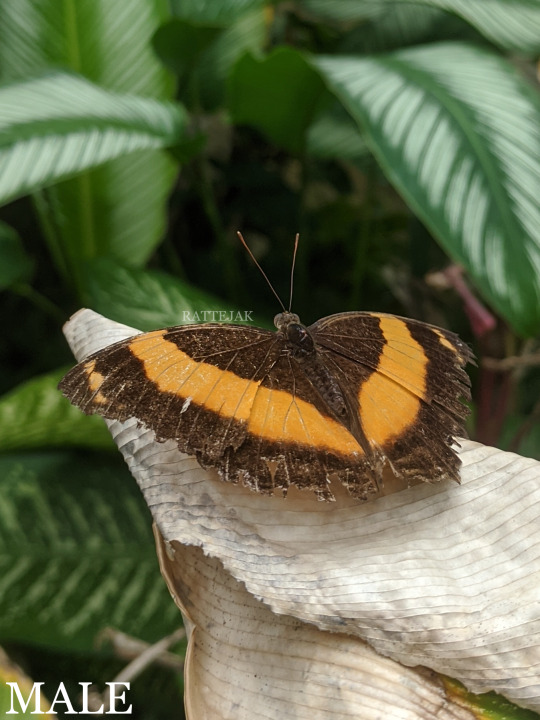

Index Entry - 10/01/21 - Yoma sabina, “The Lurcher”
Not to be confused with Cupha prosope! They look quite similar.
Taxonomy: Superfamily Papilionoidea; Family Nymphalidae; Subfamily Nymphalinae
Food plant/s: Dipteracanthus species “Australian Native Petunias”
Occupation/Territory: Australia (North QLD, NT), Java, Philippines, Taiwan, Thailand, and Vanuatu.
Sex differences: The males have very similar patterns to the females, however they lack the false eyes, have a small orange band at the tip of the forewing, and are much darker in colour.
Caterpillar description: (Placeholder image) The caterpillar is very similar in appearance to Doleschallia bisaltide, Being black, covered in branched spikes all the way down the body, two on its head resembling horns, red/orange spots on the side, and white markings. The main difference between the species, is that Yoma sabina has white lines down the back, instead of spots.
Pupae description: (Placeholder image) The pupae is also similar in shape and size to Doleschallia bisaltide, however it is angular, and has many blunt spikes.
(Source)
#yoma sabina#Salamis australis#Lepidoptera#lepidopterophobia#Papilionoidae#Nymphalidae#nymphalinae#index#index entry#adult form#adult butterfly#butterfly#butterflies#insecta#insects#insectblr#insect#insects tw#Entomology#lepidopterology#lepidopterist#bugs#bugblr#bugs tw#cute#the lurcher#arthropods#arthropoda
16 notes
·
View notes